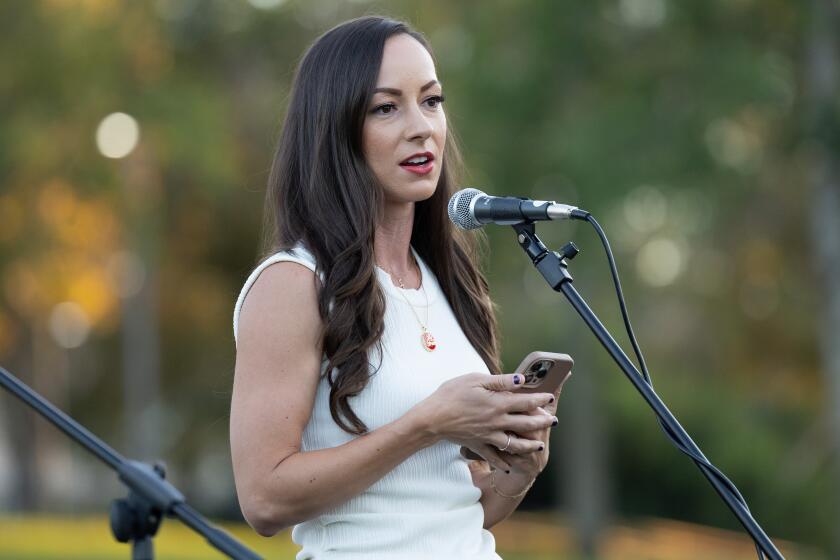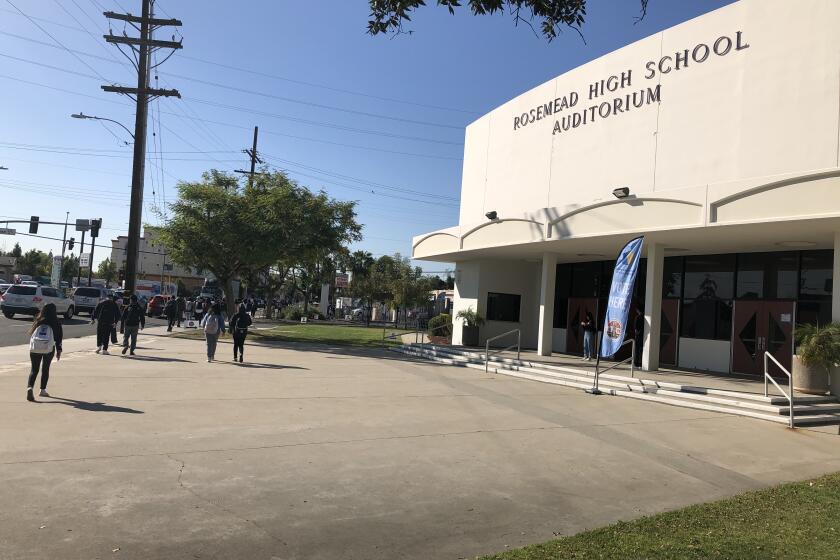A Different Kind of Campus : Education: No longer in the shadow of other state schools, Cal State Dominguez is experiencing an enrollment boom. A multicultural climate and academic opportunities have earned it high marks.
Melvin Mathews is hardly a typical university student body president. For starters, he is 45 years old. And he travels the campus in a wheelchair, the result of a stroke four years ago that left him partially paralyzed.
If Mathews is atypical, though, so is his campus--California State Dominguez Hills, located on a 346-acre site in Carson.
It is one of only three campuses among Cal State’s 20 where minorities are in the majority. The brightly colored “P.E.A.C.E.” banner hanging near the library is not a political statement. It is an advertisement--for the Pilipino Educational and Cultural Experience club.
The average Dominguez Hills student is 31 years old and more than half the student body attends classes at night.
“You have a new kind of student,” said Mathews, who plans to study law after he completes his master’s degree in communications. “You have a mortgage-paying student, a child-rearing student . . . We’re nothing like 30 years ago where your parents paid for your education.”
Dominguez Hills has spent the past 26 years in relative obscurity, juxtaposed between three major freeways, its buildings and parking lots slowly claiming more and more of the open space that once set the campus apart from its urban surroundings.
Still one of the least-known Cal State campuses, enrollment is suddenly booming--up 32% in four years. It is expected to hit 11,000 this year, at the same time overall enrollment in Cal State schools is down about 3%.
Some of Dominguez Hill’s growth came at the expense of other state schools as budget woes forced them to cut classes. Many students began to look elsewhere for the classes they needed, and they found them offered at the less crowded Carson campus.
At the same time, Dominguez Hills was reaping the benefits of an extensive promotional effort that began in the mid-1980s, when the school began visiting area high schools and junior highs to recruit students.
The university has also responded to student complaints that the campus lacks a traditional college atmosphere by doubling the number of student housing units available and opening a new student union building.
The university is advertising that full-time, incoming freshman next fall will be guaranteed housing space on campus, as well as the classes they need to graduate in four years.
Making itself an integral part of the community around it is another strategy designed to enhance Dominguez Hill’s visibility. With the city of Carson, the university formed a symphony orchestra, and with the Compton Unified School District it operates a model school program.
Its boosters say Dominguez Hills is a well-kept secret just being discovered by savvy students in search of high-quality, career-oriented programs, smaller classes and a younger, dynamic faculty.
However, the perception lingers that Dominguez Hills is a third-rate school geared to minority students whose poor academic skills keep them out of other universities.
“It had a terrible reputation at first,” said Mathews, a Compton College graduate who bypassed Dominguez Hills in favor of Cal State San Jose when he first went away to college 25 years ago.
“It was always considered a local university,” he explained. “That was the connotation, that it was inferior because it was local.”
The university, however, got high marks for its multicultural climate and the quality of its academic programs and faculty in the most recent accreditation survey-done in 1989 by the Western Assn. of Schools and Colleges. The survey team, however, chided the school for not doing enough follow-up on students to see how they fared after graduation.
The report also said Dominguez Hills should do a better job of helping students define their educational goals so they would not spend as much time in school. The average on most campuses, officials said, is for students to take four or five years to graduate. At Dominguez, he said, “It’s not extraordinary for someone to take seven years to finish.”
As the accreditation report pointed out, however, Dominguez has a higher ratio of part-time students than any other campus because such a high number--some 90%--are working at the same time they are in school.
University President Robert C. Detweiler, credited by many as the driving force behind the university’s increasing success, agrees that in many circles Dominguez Hills is perceived as an inferior school located in a ghetto area.
To counter the perception, Detweiler said, the university has to “advertise and systematically hustle. So, when I came to work for the university, we put more money, more people, more effort into what we call outreach . . . getting out to the high schools and the community colleges, trying to serve them better, (making sure) students knew about us.”
The son of migrant farm workers who moved to California from the Midwest during the Great Depression, Detweiler became president in 1989. A historian, he specializes in colonial American history, as well as slavery and racism in America and, like many administrators at the university, continues to teach a class.
As a youngster, he supported himself from the seventh grade on, for some time working on dairy farms. His own experience, say those who work with him, has produced a fierce dedication to opening higher education to as many people as possible.
“He can relate to (the) students in our service area,” said Rich W. Turner, associate vice president of university relations. “He understands poverty. He’s kind of driven to get as many kids as he can out there and onto the campus.”
For the most part, Dominguez students continue to come from inner-city neighborhoods in South-Central Los Angeles and surrounding communities.
However, neighborhood of origin does not automatically denote academic inferiority. As university officials point out, applicants to any Cal State school must meet a basic, uniform academic standard that is the same for all campuses.
True, each campus is allowed special-admits students for whom some academic requirements are waived. However, according to Dominguez officials, only 12% of this fall’s entering freshmen are in that category. In the system overall, those students last fall made up nearly 14% of the freshman class, according to figures kept by the chancellor’s office.
With a heavy minority population and the luxury to grow in relative obscurity, the ethnic diversity that characterizes Dominguez Hills has been transformed from a perceived liability into a deep source of pride, if not a virtue, as far as many are concerned.
Detweiler said the diversity is a philosophy that adds, strengthens and enlightens. Black students represent 31% of the student population, with Latino students at 16%, Asians at 7% and Anglo students at 42%.
“The ethnic diversity and the age diversity, I love it,” said Joel A. Colbert, associate professor in the Department of Education. It “adds to the strength of our campus.”
Education is one of the largest departments on campus and faculty members take pride in having produced a large portion of California’s corps of minority teachers. Also, the department is the first in the nation to set up a special program to retrain retired and laid-off aerospace engineers and scientists to teach math in public schools.
“Here, there’s all races, different backgrounds,” said David Barnes, a black student from Riverside. “When I came here as a freshman, I didn’t know people worshiped Buddha.”
“It’s pretty racially diverse,” said Juan Gutierrez, 19, president of the campus Hispanic student business association. “I’ve been here two years now and I can’t imagine going anywhere else. I got into (Cal State) Long Beach and I thought, this (Dominguez Hills) is small, I’ll go here for my general ed and then transfer. I’m not going to transfer now.”
Indeed, the ethnic and cultural diversity enliven day-to-day life on a campus that would otherwise have little to distinguish it from the next state school dominated by commuter students and institutional architecture.
For example, inside the newly built student union, Taco Bell and Carl’s Jr. offer their standard fare. On a recent day outside, however, students lined up to buy pupusas they washed down with ice-cold glasses of horchata and tamarindo . The Central American Student Assn. sells the luncheon fare every three months to raise money for its scholarship fund.
Here, too, black students, who make up a mere 6% of all students in the Cal State system, play active leadership roles in student government and other aspects of campus life.
Dominguez Hill’s black enrollment far out distances that of any other Cal State campuses. The only two other campuses that come close are Hayward, with about 12%, and Los Angeles, with about 11%.
Moreover, 29% of the 1991 graduating class was black, according to Kenneth Gash, the university director of institutional research. “What it shows,” Gash said, “is we don’t have what might be called a revolving door, a situation where we admit (black) students but don’t graduate them.”
“Hell, yes,” said Barnes, when asked if having large numbers of black males on campus made him more comfortable. He would feel less comfortable on a largely white campus, he said.
Terrell Arnold, a 37-year-old black male who is finishing up his college degree at Dominguez and also working in the university’s outreach recruitment program, said, “I just think there’s something about this school that makes you feel very comfortable.”
He compares it to a “private eastern university,” explaining that professors go out of their way to get to know the students, to learn their names, to empathize with their problems.
“It’s just the atmosphere here,” Arnold said. “They’re very caring. They nurture you.”
That atmosphere, said faculty members, is a result of what they believe is a “critical mass” theory, that when large numbers of different racial groups are present and no one group is dominant, everyone’s comfort level increases.
While racial tensions in the neighborhoods where the students live may boil over with despairing frequency, the campus remains surprisingly free of such tensions. Several faculty and staff members referred to a recent survey done by the university asking students, among other things, if they felt any racial discrimination or discomfort on campus. Students responded that they felt a high level of comfort and security.
The school’s mission to promote racial diversity in higher education, said Yolanda T. Moses, vice president for academic affairs, is the path to racial harmony in the larger world.
The university, she said, is building the model that “must be replicated” if communities are to “survive.”
The Student Body The enrollment at Cal State Dominguez Hills, one of the most demographically diverse schools in the state university system, has jumped nearly a third over a four-year period. Enrollment Growth 1987 Through 1991 Dominquez 1987: 7,869 1991: 10, 364 (32% increase) Cal State System Overall 1987: 342, 776 1991: 361, 904 (5% increase) Cal State Students Ethnic Breakdown Dominquez Black: 31% Latino: 16% Asian: 7% Filipino: 3% American Indian: 1% White: 42% Cal State System Overall Black: 6% Latino: 14% Asian: 13% Filipino: 4% American Indian: 1% White: 62% Note: Pacific Islanders account for 0.4% of students systemwide and 0.5% at Cal State Dominquez Hills. Source: Office of the Chancellor, California State University System.
Cal State Dominguez Hills Location: Carson
Founded: Opened in Rolling Hills Estates in 1965. Moved to current site in Carson in 1966.
Enrollment: 11,000*
Average student age: 31
Student fees: $1,308 per year for 6.1 units or more; $756 per year for 6 units or less.
On-campus resident capacity: 710
Faculty: 387
Acreage: 346
* Approximate, fall 1992.
More to Read
Start your day right
Sign up for Essential California for news, features and recommendations from the L.A. Times and beyond in your inbox six days a week.
You may occasionally receive promotional content from the Los Angeles Times.






